
The Gwich'in
(briefly)
by
Jean-Luc Pilon
NOGAP Archaeologist
Canadian Museum of Civilization
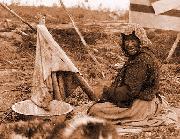
Introduction
There were no chroniclers of Gwich'in history in the Northwest Territories.
Instead, such written sources as do exist for the first century or
so following the first recorded contact between the Gwich'in and Europeans
are indirect in nature. These observations were recorded in the daily journals
of traders who needed to understand how to increase fur yields,
in the letters of missionaries who were primarily concerned with the next
life or in the writings of travellers/adventurers who had other preoccupations.
Descriptions of various aspects of the Gwich'in lifestyle were usually included only
in as much as they related to these overarching purposes or they struck the writers as
curiosities worthy of brief notes. Thus, vast amounts of
information went by un-noticed or unrecorded. The task of extracting useful
anthropological and historical knowledge from these writings becomes the
ethnohistorians art.
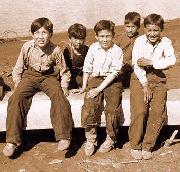 There is one other unfathomed yet rapidly dwindling body of knowledge
about the past which has yet to be fully or even partially exploited: oral
history. The sharing of information and knowledge in traditional native North American
societies was achieved primarily through oral transmission: stories, explanations,
descriptions were recounted, listened to and passed on from one generation
to the next. As we near the end of the twentieth century, this cycle has been
seriously threatened and undermined. There is a great urgency to record what
remains.
There is one other unfathomed yet rapidly dwindling body of knowledge
about the past which has yet to be fully or even partially exploited: oral
history. The sharing of information and knowledge in traditional native North American
societies was achieved primarily through oral transmission: stories, explanations,
descriptions were recounted, listened to and passed on from one generation
to the next. As we near the end of the twentieth century, this cycle has been
seriously threatened and undermined. There is a great urgency to record what
remains.
The overview of the Gwich'in people which is presented here is based primarily on published historical and ethnohistorical accounts and suffers greatly by the absence of any significant amount of traditional knowledge.
Distribution
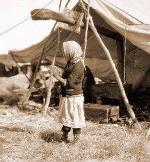 The Gwich'in, the northernmost Athapaskan-speaking group, traditionally occupied a vast expanse
of land covering large portions of interior northern Alaska and Yukon with the easternmost groups
living along the lower reaches of the Mackenzie Valley. Historically there were ten named
Gwich'in groups or bands (Krech 1979a). The Eastern Gwich'in of the Mackenzie Valley,
comprised of the Tetlit Gwich'in and Gwichya Gwich'in, today live mainly in the communities of
Fort MacPherson (Tetlit Zhe) and Tsiigehtchic (formerly Arctic Red River)
respectively, with members of both groups also being found in Aklavik and Inuvik. Traditionally,
the Gwichya Gwich'in occupied lands well into the Mackenzie Delta, then followed the treeline
towards the Anderson River, down to Thunder River from there south into the Mackenzie
mountains up the Arctic Red River. The Tetlit Gwich'in are their neighbours and cousins. Their
lands extended to the west into the Richardson Moutains and south, up the Peel River into the
Mackenzie mountains.
The Gwich'in, the northernmost Athapaskan-speaking group, traditionally occupied a vast expanse
of land covering large portions of interior northern Alaska and Yukon with the easternmost groups
living along the lower reaches of the Mackenzie Valley. Historically there were ten named
Gwich'in groups or bands (Krech 1979a). The Eastern Gwich'in of the Mackenzie Valley,
comprised of the Tetlit Gwich'in and Gwichya Gwich'in, today live mainly in the communities of
Fort MacPherson (Tetlit Zhe) and Tsiigehtchic (formerly Arctic Red River)
respectively, with members of both groups also being found in Aklavik and Inuvik. Traditionally,
the Gwichya Gwich'in occupied lands well into the Mackenzie Delta, then followed the treeline
towards the Anderson River, down to Thunder River from there south into the Mackenzie
mountains up the Arctic Red River. The Tetlit Gwich'in are their neighbours and cousins. Their
lands extended to the west into the Richardson Moutains and south, up the Peel River into the
Mackenzie mountains.
Traditional Economy
Although much of the homeland of the Gwich'in lies above the Arctic Circle, environmental
conditions are tempered by Pacific weather systems. Their forested arctic environment offered a
wide range of resources from which to draw sustenance, tools and shelter. Theirs was very much
a mixed economy with fish, waterfowl, and both small and large game contributing to the larder as
these became seasonally available. It might be argued that some resources, by their seasonal
abundance, were of critical importance, such as the salmon fishery along the Yukon River and
caribou in the Old Crow Flats. Tsiigehtchic elders have recounted how spring fisheries could
make the difference between life and death after a particularly long and meagre spring (Andre
1991). Animal bones found in southwest Anderson Plain archaeological sites clearly indicate that
caribou was a major species sought after at all times of the year. In fact, a number of sites
appear to represent specialized fall caribou hunting localities.
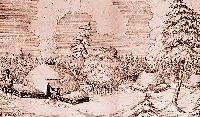 Permanent settlements are recent and necessity required the Gwich'in to cover
extensive territories in their annual cycle, but some localities appear to have been revisited with some
frequency. For example, Vidiitshuu Leetak, a site at the head of Vutediujik (Kugaluk River)
River has cultural remains spanning at least four thousand years. The most recent use is a cabin
built there in the 1970s and used for caribou hunting and fall fishing. While skin and possibly
bark-covered domed dwellings were reported, more substantial constructions of poles and sod
were also employed. A well-known type of winter dwelling is the moss house or "nynkun", still
remembered by Tsiigehtchic elders (Andre and Kritsch 1992). Another possibly older form of winter dwelling seems to have
combined a cold-trap with a gabled roof comprised of earth and moss-covered poles supported by
A-frames.
Permanent settlements are recent and necessity required the Gwich'in to cover
extensive territories in their annual cycle, but some localities appear to have been revisited with some
frequency. For example, Vidiitshuu Leetak, a site at the head of Vutediujik (Kugaluk River)
River has cultural remains spanning at least four thousand years. The most recent use is a cabin
built there in the 1970s and used for caribou hunting and fall fishing. While skin and possibly
bark-covered domed dwellings were reported, more substantial constructions of poles and sod
were also employed. A well-known type of winter dwelling is the moss house or "nynkun", still
remembered by Tsiigehtchic elders (Andre and Kritsch 1992). Another possibly older form of winter dwelling seems to have
combined a cold-trap with a gabled roof comprised of earth and moss-covered poles supported by
A-frames.
First Descriptions-Early Contact
 Alexander Mackenzie, a partner in the Northwest Company, is attributed with the first written
description of the easternmost Gwich'in people and their country as he made a failed attempt to
find a route to the Pacific Ocean in 1789. However, archaeological evidence recovered at the
mouth of the Arctic Red River suggests that some contact, albeit only indirect, had taken place
prior to this voyage (Nolin 1993). Indeed, trade, likely through intermediaries, was surely occurring with the
Russian traders established along the coast of southern Alaska.
Alexander Mackenzie, a partner in the Northwest Company, is attributed with the first written
description of the easternmost Gwich'in people and their country as he made a failed attempt to
find a route to the Pacific Ocean in 1789. However, archaeological evidence recovered at the
mouth of the Arctic Red River suggests that some contact, albeit only indirect, had taken place
prior to this voyage (Nolin 1993). Indeed, trade, likely through intermediaries, was surely occurring with the
Russian traders established along the coast of southern Alaska.
The Fur Trade
While a trading post was established near present-day Fort Good Hope early in the XIXth century
and even at the edge of the Gwich'in territory for a short while (1823-27), a permanent Euro-
Canadian presence on Gwich'in lands did not occur before the establishment of Fort MacPherson
in 1840 (Krech 1979b; Usher 1971). Much debate has taken place surrounding the effects that
sustained contact between such economically, technologically, culturally different peoples might
have had. While there is no doubt that the establishment of Fort Good Hope
and especially Fort MacPherson signalled the full participation of the Gwich'in in the fur trade, the
break with the past was not immediate. For instance, in 1870, Father Jean Séguin wrote to his
sister in France that refusal by the Fort MacPherson traders to advance the Gwich'in hunters
guns and ammunition forced them to spend the winter hunting with bows and arrows. (n.d.: HEF
456.J43R:205). Throughout Séguin's writings, which comprises two typed and bound volumes, it
is clear that caribou hunting and fishing are critical to the involvement of the local native people
(Hare and Gwich'in) in the fur trade. As elsewhere in the Subarctic (see Francis and Morantz 1983), fur
trapping may only have been possible once subsistence needs had been met.
In the first half of the XIXth century, one of the principal trade goods much sought after by the Gwich'in were beads. These had taken on a very powerful role in Gwich'in society and functioned as a highly-valued prestige item. Only once the traders' supply of beads had been exhausted were other items bartered for (Krech 1979b). Oddly enough, with the single exception of the site at the Flats at Tsiigehtchic, beads are extremely scarce on archaeological sites of the southwest Anderson Plain. Perhaps this is a true measure of their value.
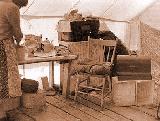 Exchanges between the Gwich'in and the Euro-Canadian traders might also have affected the
relationship between the Gwich'in and their neighbours to the north, the Mackenzie Inuit.
Following the establishment of trading centres and up until the mid-XIXth century, the Gwich'in
played the role of middlemen between the traders and the Mackenzie Inuit. Their access to guns
gave them a marked advantage which, however, might have become weakened by the effects of
diseases. The first half of the 1800s is marked by rather hostile and violent confrontations
interspersed by friendly relations (Krech 1979b).
Exchanges between the Gwich'in and the Euro-Canadian traders might also have affected the
relationship between the Gwich'in and their neighbours to the north, the Mackenzie Inuit.
Following the establishment of trading centres and up until the mid-XIXth century, the Gwich'in
played the role of middlemen between the traders and the Mackenzie Inuit. Their access to guns
gave them a marked advantage which, however, might have become weakened by the effects of
diseases. The first half of the 1800s is marked by rather hostile and violent confrontations
interspersed by friendly relations (Krech 1979b).
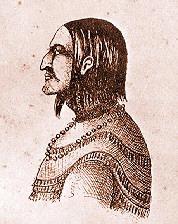 Writing in the late 1800's, the Oblate missionary Father Émile Petitot (1876) identified two named
groups of Gwich'in people living along the lower course of the Mackenzie River: the Nakotcho
Gwich'in and the Gwichya Gwich'in (on the right is a sketch by É.Petitot
of Sa-viah, Sun-Beam, chief
of the Gwichya Gwich'in (in Savoie 1970:116)). When Cornolius Osgood (1936) visited the region more than
fifty years later, there was only one named group, the Gwichya Gwich'in. The fate of the Nakotcho
Gwich'in is the subject of some speculation on the part of ethnohistorian Shepard Krech who has
proposed that severe changes were brought about by the introduction of diseases by the fur
traders (and perhaps even the missionaries). The severity was such that "in the 1860s,
one Kutchin was alive where six had been aboriginally" (Krech 1978:99). This may,
in turn, have forced, for simple biological necessity, the coalescence of the remnants of the former
Gwich'in bands into a single one which maintained the identity of the Gwichya Gwich'in.
Archaeological information certainly seems to support the notion of the abandonment of the
southwest Anderson Plain during the early contact period until at least the late XIXth/early XXth
century.
Writing in the late 1800's, the Oblate missionary Father Émile Petitot (1876) identified two named
groups of Gwich'in people living along the lower course of the Mackenzie River: the Nakotcho
Gwich'in and the Gwichya Gwich'in (on the right is a sketch by É.Petitot
of Sa-viah, Sun-Beam, chief
of the Gwichya Gwich'in (in Savoie 1970:116)). When Cornolius Osgood (1936) visited the region more than
fifty years later, there was only one named group, the Gwichya Gwich'in. The fate of the Nakotcho
Gwich'in is the subject of some speculation on the part of ethnohistorian Shepard Krech who has
proposed that severe changes were brought about by the introduction of diseases by the fur
traders (and perhaps even the missionaries). The severity was such that "in the 1860s,
one Kutchin was alive where six had been aboriginally" (Krech 1978:99). This may,
in turn, have forced, for simple biological necessity, the coalescence of the remnants of the former
Gwich'in bands into a single one which maintained the identity of the Gwichya Gwich'in.
Archaeological information certainly seems to support the notion of the abandonment of the
southwest Anderson Plain during the early contact period until at least the late XIXth/early XXth
century.
The Modern Period
Although the Gwich'in were active in the fur trade throughout the XIXth century, they remained on
the land, shifting territories in response to the abundance of fur bearers and food animals. It was
not until the beginning of the XXth century that people began to settle at what would become the
communities of Tsiigehtchic and Fort MacPherson. These localities had basically been summer
gathering places with religious and trading functions. The presence of American whalers at
Herschel Island and the later Yukon Gold Rush also added a police function to Fort MacPherson.
Perhaps the most dramatic changes came about in the early part of the present century with the building of a hospital and a residential school in Aklavik. The substitution of some of the educational and health functions previously carried out within families and local residential groups likely marks a watershed of proportions even greater than any which might be imagined as a result of first contacts.
During the twentieth century contacts increased with the "outside" world. There was both an increase in the number of non-Natives settling or working in the lower Mackenzie Valley and a growing presence of government agents. This culminated with the establishment of the town of Inuvik, whose avowed purpose was to bring the south to the north.
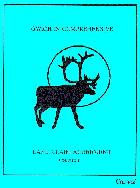 Through all of this, the processes of change was controlled from without.
During the 1970's and 1980's new positions were established and these
culminated in the signing of the Gwich'in Comprehensive Land Claim Agreement on April 22,
1992. The future, as uncertain as it might be anywhere else, at least has
the potential of being shaped, to a greater degree, by the Gwich'in themselves.
Through all of this, the processes of change was controlled from without.
During the 1970's and 1980's new positions were established and these
culminated in the signing of the Gwich'in Comprehensive Land Claim Agreement on April 22,
1992. The future, as uncertain as it might be anywhere else, at least has
the potential of being shaped, to a greater degree, by the Gwich'in themselves.



